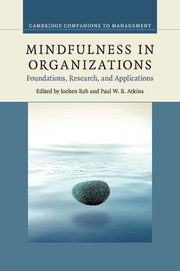Book contents
- Frontmatter
- Contents
- List of figures
- List of tables
- List of contributors
- Foreword
- Preface
- Part I Foundations
- Part II Research
- 6 Mindfulness, identity and work: mindfulness training creates a more flexible sense of self
- 7 Improving decision making through mindfulness
- 8 Mindfulness and creativity in the workplace
- 9 How being mindful impacts individuals' work-family balance, conflict, and enrichment: a review of existing evidence, mechanisms and future directions
- 10 Building and maintaining better leadership relationships through mindfulness
- 11 Leading with mindfulness: exploring the relation of mindfulness with leadership behaviors, styles, and development
- 12 Mindfulness in interpersonal negotiations: delineating the concept of mindfulness and proposing a mindful, relational self-regulation (MRSR) model
- 13 Drawing the line: sketching out the role of visual templates in individual mindfulness and mindful organizing
- Part III Applications
- Index
- References
9 - How being mindful impacts individuals' work-family balance, conflict, and enrichment: a review of existing evidence, mechanisms and future directions
from Part II - Research
Published online by Cambridge University Press: 05 July 2015
- Frontmatter
- Contents
- List of figures
- List of tables
- List of contributors
- Foreword
- Preface
- Part I Foundations
- Part II Research
- 6 Mindfulness, identity and work: mindfulness training creates a more flexible sense of self
- 7 Improving decision making through mindfulness
- 8 Mindfulness and creativity in the workplace
- 9 How being mindful impacts individuals' work-family balance, conflict, and enrichment: a review of existing evidence, mechanisms and future directions
- 10 Building and maintaining better leadership relationships through mindfulness
- 11 Leading with mindfulness: exploring the relation of mindfulness with leadership behaviors, styles, and development
- 12 Mindfulness in interpersonal negotiations: delineating the concept of mindfulness and proposing a mindful, relational self-regulation (MRSR) model
- 13 Drawing the line: sketching out the role of visual templates in individual mindfulness and mindful organizing
- Part III Applications
- Index
- References
Summary
Introduction
Growing exponentially over the past several decades, the topic of work and family has fueled a large body of scholarship (see Allen 2012 for a review). Interest in work and family is expansive. The struggle to balance work and family is one that resonates with many adults. It is a topic of concern to organizations (Society for Human Resource Management Workplace Forecast 2008) and to societies across the globe (Poelmans, Greenhaus, and Las Heras Maestro 2013). Indeed, work-family issues have captured the attention of the public at large, frequently appearing as a focal topic in the popular press with titles such as “Why Women Still Can's Have It All” (Slaughter 2012) and “Men Want Work-Family Balance, and Policy Should Help Them Achieve It” (Covert 2013).
To date, the majority of work-family scholarship has focused on situational factors that help or inhibit individuals' abilities to manage multiple role responsibilities. This focus has resulted in a considerable body of work that has demonstrated links between stressors and demands emanating from the work and the family domains with constructs such as work-family conflict (Michel, Kotrba, Mitchelson, Clark, and Baltes 2011). Much of the attention aimed at reducing work-family conflict has centered on organizational practices such as flexible work arrangements and dependent care supports, despite findings that such practices have limited effectiveness in terms of alleviating work-family conflict (Allen et al. 2013; Butts, Casper, and Yang 2013). Work-family intervention research has focused on training supervisors to be more family-supportive (e.g., Hammer et al. 2011) or on flexible work practices (e.g., Perlow and Kelly 2014). Such approaches are based on the notion that experiences such as work-family conflict are primarily provoked by the situation.
There is also a growing body of research that demonstrates that personality variables are associated with work-family experiences, which suggests that individual differences beyond demographic variables also contribute to work-family experiences (Allen et al. 2012).
- Type
- Chapter
- Information
- Mindfulness in OrganizationsFoundations, Research, and Applications, pp. 213 - 238Publisher: Cambridge University PressPrint publication year: 2015
References
- 20
- Cited by

